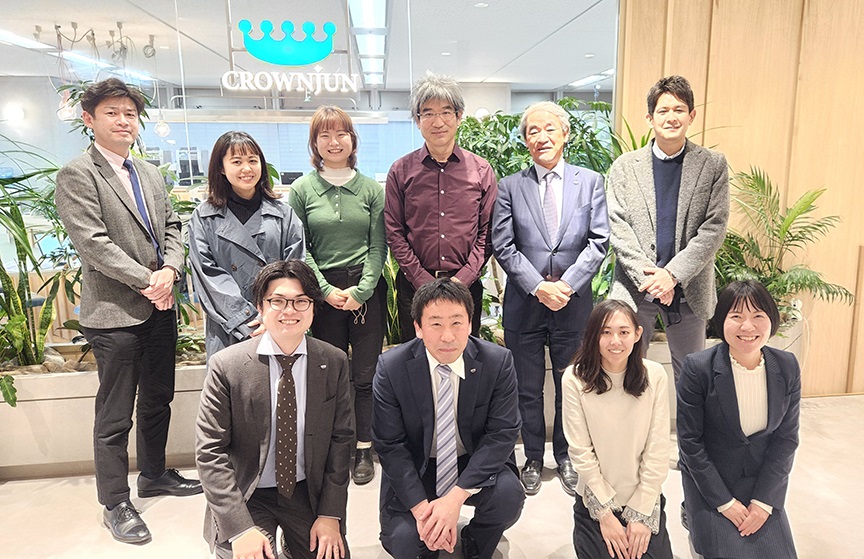Hello! This is Mori from the Corporate Communication Division!
This is part two of the article introducing our New Factory Project.
In this article, I focused on:
- The introduction of the members from the University of Tsukuba
- The report of the project meeting
- The image of our company
Related Article

Introduction of the Members from the University of Tsukuba

Project members are Mr. Kazuyoshi Watari, Associate Professor, Faculty of Art and Design, University of Tsukuba, and Ms. Ito and Ms. Ohinata, who are studying at his lab. Their idea based on knowledge and experience as specialists are always stimulating, and they already become the key persons in the project. I interviewed them to know the basin of their idea.
Placemaking in Tsukuba
The members’ research takes place in Tsukuba. Mr. Watari engages in various activities according to his research theme “Placemaking*.” After working in the development of the Tsukuba Expo and Tsukuba Express, he gained experience in the United States. Now, he has set his main field in Tsukuba, teaches at the University of Tsukuba, and conducts presentations on placemaking by the offer of the Ministry of Land, Infrastructure, Transport and Tourism.
*Placemaking is the idea or method to create a place that is comfortable for each person. Mr. Watari has set up 8 factors that create a comfortable place. Based on these factors, he has been researching the framework that each of us feels comfortable without colliding with others.

Ms. Ito and Ms. Ohinata moved to Tsukuba when entering university. Having interests in the people, history, and new technology, they have set their research in Tsukuba. Ms. Ito focuses on the connection between inside and outside, and Ms. Ohinata focuses on the people’s activity and place. For her graduation thesis, Ms. Ito utilized the steel frame which was originally the material used in a house, and Ms. Ito set up an event using a ruined gas station. The idea for their theses came into their mind when walking in Tsukuba. They are now studying in graduate school, and continuing their studies.
Joining the Project Meeting
Our company is pursuing to develop a place for open innovation in this project. By attending this project, I felt that the meeting itself was innovative: all the members, regardless of position and age, were giving opinions and ideas for the creation of a good architecture.
On the day I joined the meeting, the topic was the interim report to our president and the consideration of the exterior. First, Ms. Ito shared her 3D drawings. All the members of our company were interested in the drawings using the latest software that can reflect the season, weather and time of the appearance. Next, the actual example of architecture which contains the idea that the project members gave in the current meeting was introduced. Many examples were applied to the drawings. The meeting was full of suggestions; there were discussions over the color of the building, and conversations emerged such as “This kind of activities can take place in this zone” or “This place can be opened to the public on weekends.” The new factory started to have a certain shape.

How Our Image Changed from “Stubborn Craftsmen”
A year has passed since we started working with the members from the University of Tsukuba. It seems that we have constructed a credible relationship, regardless of where we belong to. I interviewed them about the image of the Kono Seisakusho Group.
Mr. Watari: The importance of architecture relies on how it is utilized after construction. We can only participate until the construction, so the architecture after being constructed depends on the people who use it; I believe that the people in Kono Seisakusho Group can manage it well because they have been engaging in the designing process, which is quite rare. It was new for me to see the staff members drawing images and holding meetings frequently to discuss how to use the architecture. Joining the construction process matters a lot to the utilization of the architecture, so I am looking forward to seeing what it is going to be like in the future.
Ms. Ito & Ms. Ohinata: The staff members are bright and they create a very nice working environment. On the first hand, we assumed that the people working at the factory would be stubborn craftsmen. They turned out to be kind people with open minds, seeking a new style of work and having an interest in multiple fields. We are motivated for this project because they provided us with many ideas for the design plan that we have made.

Conclusion
Mr. Watari, Ms. Ito, and Ms. Ohinata thank you for cooperating with our interview!
They have introduced us to many stories, which I was unable to put all in this article, including “Tenshiba” in Osaka. Although visiting many times, I gained a new perspective on “Tenshiba” by listening to the opinions of Mr. Watari.
Dear readers, if you have a favorite place to visit, try applying the idea of “placemaking.” What seems to be there without consideration may be the key factor for the comfortableness.




